Amalfi reboot: Italy’s buzziest new hotel
Inside Borgo Santandrea, the first high-end hotel to open on this celebrated coastline in more than a decade.
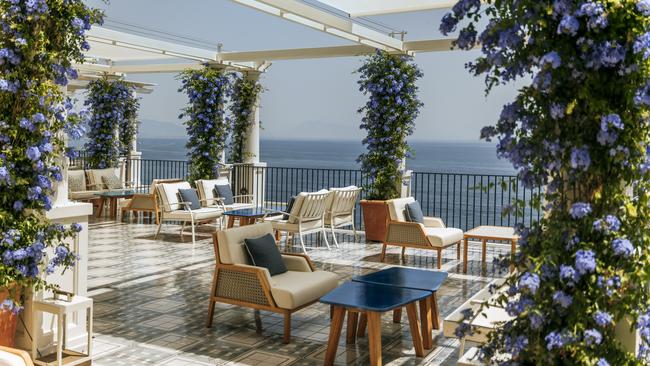
Discover the world’s latest and greatest luxe lodgings in issue 8 of Travel + Luxury magazine.
Why would anyone want to “disrupt” the exquisite Amalfi? It’s a question that was pondered by the owners of Borgo Santandrea, the first luxury hotel to open on this venerated coastline in 15 years. When faced with perfection – and an area dominated by grandiose hotels steeped in Italian glamour and nostalgia – what should one do? Apparently, create a property that’s completely, utterly and sublimely different. For the Orlacchios and De Sianos, two families who run neighbouring hotels on nearby Ischia, the chance to be disruptive came when the ageing Il Saraceno Grand Hotel appeared on the market. Set beside the charming fishing village of Conca dei Marini and emerging from the mouth of a gargantuan cave above, it was an imposing property with a medieval-style façade and heavy Moroccan-inspired décor. But if you could look beyond this unconvincing aesthetic, its foundations revealed its 1960s roots, hinting at the more modernist renovation its soon-to-be-owners had in mind.
Over the next four years, in a revamp led by architect Rino Gambardella, they had the Moorish interiors stripped out and replaced with marble columns and arched windows reminiscent of the classical architecture of ancient Italy. Walls were knocked down to create far more generous guest rooms: 45 in total, including 16 suites, eight with private plunge pools. Floors were ripped up and in their place myriad tiles laid. Thirty-one different geometric designs, from chevrons to herringbones to basketweaves, were conceived for the property, all in varying shades of blue and white, and handmade and painted by local artisans. They now stretch out before you in lobbies, terraces and suites, a sea of colour perfectly complementing the ocean view beyond. A hanging installation of 450 handmade ceramic anchovies took a painstaking two years to complete and now sways in the light breeze that whispers through the hotel, its spherical shape recalling a shoal of fish rushing to the surface of the sea. Terraced gardens were also installed, adding another lush layer to the proceedings.
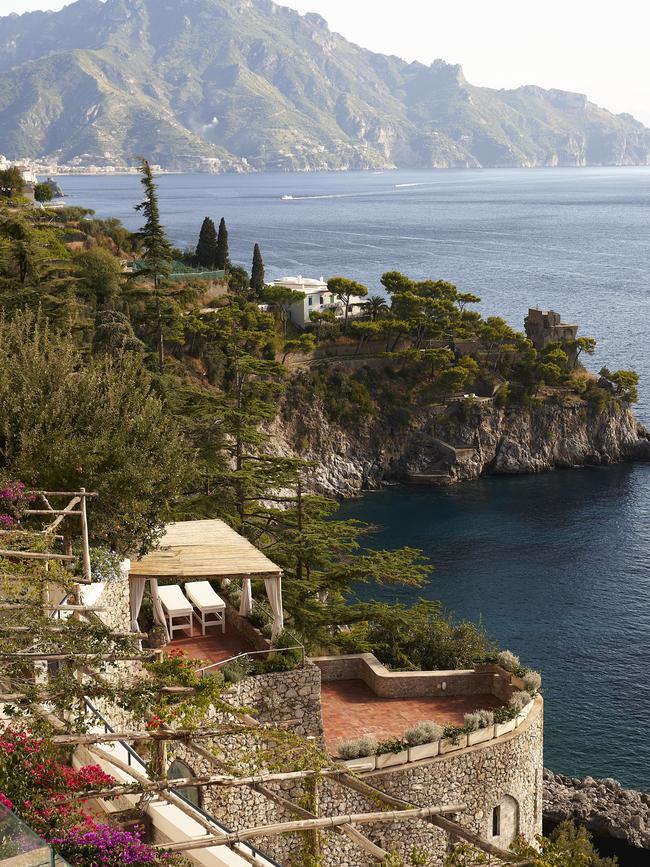
Equally impressive are the mid-century furnishings. Each corner of the hotel is filled with armchairs by Hans Wegner, Erik Worts or Fredrik A Kayser, reupholstered in 1930s fabrics designed by Gio Ponti and reproduced by the Venetian textile brand Rubelli. The concierge desk is an original Carlo Mollino glass-topped dining table; a Gerald Thurston table lamp sits atop the check-in desk. Yet for all the beauty inside – the milky-white walls, sea of blue tiles and highly covetable furniture – it’s still the outside that truly takes your breath away. (If you can, request room 608, a corner suite with double-aspect views and the most beautiful bathroom ever.) To the left one can see Amalfi town (three kilometres via a winding coast road), to the right the handful of buildings that appear to have tumbled down the cliff is Conca dei Marini, and in between is the infinite blue of the Tyrrhenian Sea dotted with yachts and fishing boats, some gliding through the water, others bobbing lazily.
People-watching is what the Amalfi Coast has been famed for since Jackie Kennedy and Sophia Loren holidayed here in the 1960s, but to come to Borgo Santandrea is to spend your time marvelling at its lack of people – bold-faced or otherwise. It manages never to feel busy (during my visit I had no clue the hotel was almost full). Whether you’re savouring a homemade Amalfi lemonade on the terrace, swimming lengths in the pristine pool or stretching out on the private beach, there’s plenty of space for everyone. A path zigzags from the hotel (a perilous 90 metres above sea level) down to the beach, weaving through fragrant lemon trees, climbing jasmine, roses and blue myrtle, all perfuming the air. Its 300-plus steps give you a workout, and also ample photo opportunities. (Given the dramatic verticality of the property, eight lifts also transport guests from the top of the hotel to the beach.) At the bottom you’re rewarded with a private beach club with striped changing huts, paddleboards to loan and a drinks service.
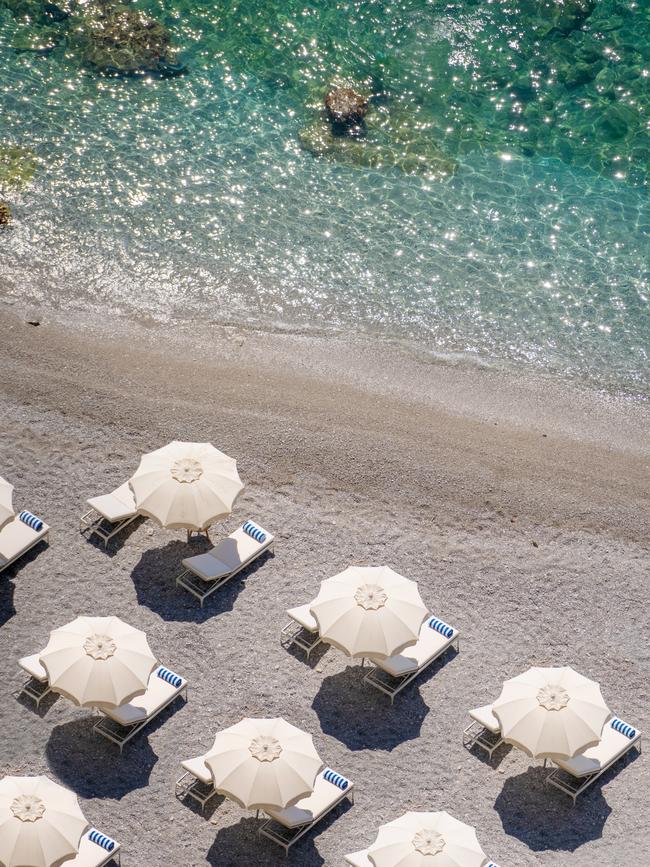
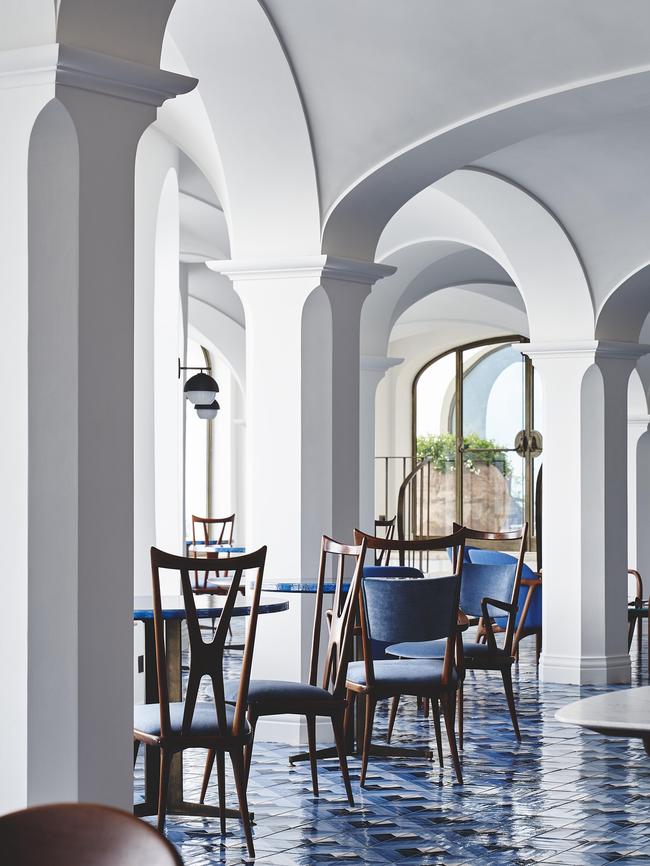
It’s here you’ll receive the most laid-back culinary offerings, too. The hotel has three restaurants: one by the pebbly shore serving pizzas, salads and spaghetti, while back at the top of the hotel Alici delivers a modern spin on classics, from deep-fried zucchini flowers stuffed with ricotta and anchovies to the region’s renowned delizia al limone, a mini sponge cake filled with lemon custard. La Libreria is the hotel’s grandest option, decked out with floor-to-ceiling walnut bookshelves and Sicilian lava stone dining tables, and acclaimed chef Crescenzo Scotti’s chance to get really creative. His eight-course tasting menus are inspired by the region, featuring tiny morsels of osso buco, scamorza cheese (still smoking inside lemon leaves) and a deconstructed version of a pudding his nonna used to make.
Despite all its rarefied luxury, Borgo Santandrea is a family-run business and that’s the vibe its owners hope to convey. The staff are warm and convivial; co-owner Maurizio Orlacchio, who honed his hospitality skills at Four Seasons hotels across the US and Europe, welcomes guests to breakfast every morning. The magnificent buffet of fruit, cold meats, local cheeses and a bounty of breads and pastries is served inside the chef’s kitchen to further encourage guests to consider it a lavish home away from home. This is a place where the waiters remember your name and chocolate cakes with “Happy anniversary” in loopy writing appear in your bedroom.
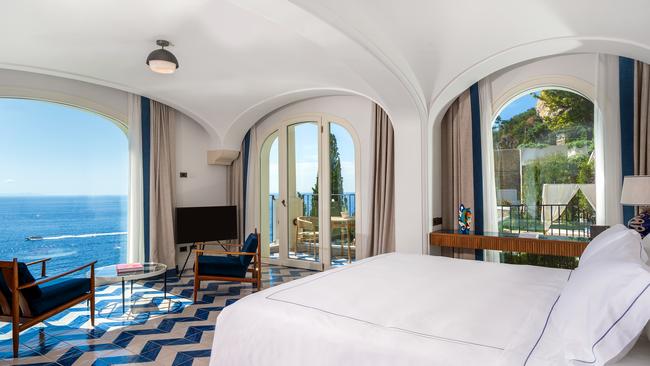
We could have happily stayed put in this white and blue haven, but the lure of the neighbouring towns was too much to pass up. We spent one afternoon wandering around Amalfi town, where the pasticceria Andrea Pansa is an unmissable stop for espresso con panna, a short coffee with sweetened whipped cream, and a Santa Rosa, a pastry horn filled with custard and cherries, first created by the nuns in the nearby monastery. From here we take a 20-minute ferry ride to Positano. It’s far quicker and cheaper to travel by boat – the summer months bring more coaches, scooters, hire cars and polizia, along with a cacophony of horns, to the solitary coast road.
Positano lives up to the hype, but it can be confronting depending on your sensibilities. Its tiny spaghetti streets are as filled with tourists as its beach is with uniform sunbeds packed like sardines. It’s a riot of restaurants, boutiques and ceramics shops, yet while there are about 4000 residents, an additional 12,000 tourists visit every day during the summer months, so expect a squeeze. Join the queues at Gelateria Buca di Bacco – it’s worth it for the homemade ice-cream, with flavours such as hazelnut, pistachio and, of course, Amalfi lemon. Then find a restaurant that serves spaghetti alla Nerano (with fried zucchini), the dish made famous by Stanley Tucci on his recent BBC series, Searching For Italy. Luckily it’s a local speciality and on most menus; I ate a huge, delicious plate of it at La Cambusa, near the seafront. It’s deceptively simple yet utterly moreish.
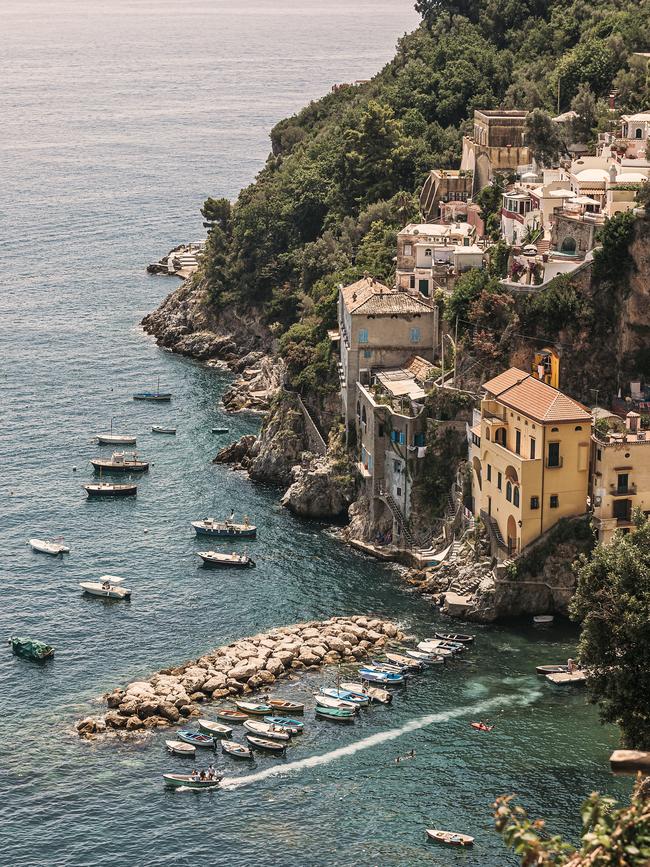
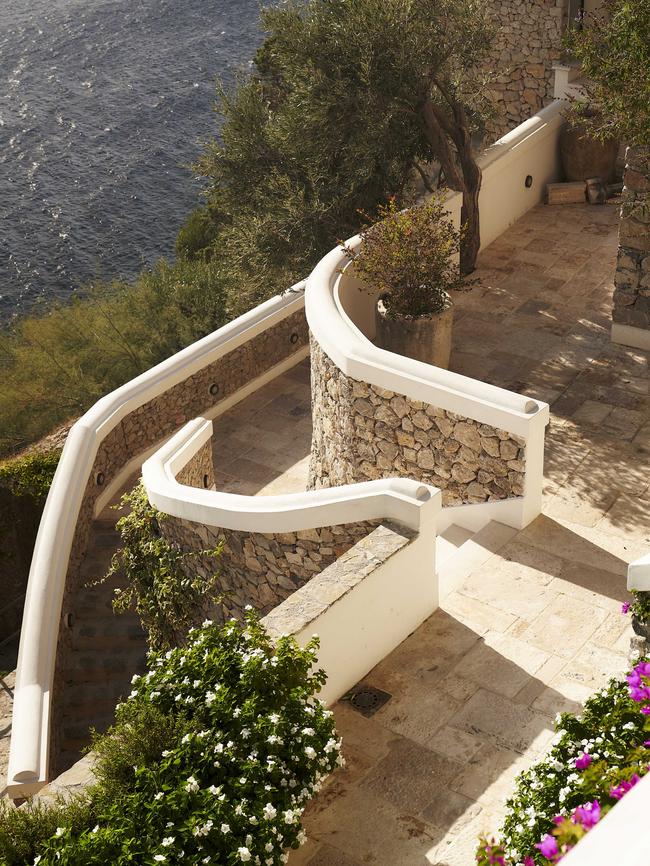
We couldn’t visit Positano without also checking out Le Sirenuse, the town’s most famous hotel – and arguably Borgo Santandrea’s biggest rival for the It crowd. It’s where John Steinbeck, Elizabeth Taylor and Reese Witherspoon (who honeymooned here) have stayed since it opened in 1951. Fascinatingly, the two properties couldn’t be more different. Apart from both being family-run hotels, Le Sirenuse is everything Borgo Santandrea is not: saturated with rich colour, eclectic and eccentric, layering the family’s historic paintings with modern art (Martin Creed’s neon Don’t Worry sign in a bar and Matt Connors’ laminated panels in the lobby), floor-to-ceiling hand-painted murals, a jungle of foliage and an attitude that more is more. It’s beautiful and bustling. A place to see and be seen. The latest addition, Franco’s Bar, an alfresco cocktail lounge with a citrine-yellow Neo-Baroque fountain, dubs itself “Positano’s coolest meeting place” and has lines outside an hour before it opens.
It’s hard not to fall in love with it, too, but Le Sirenuse offers a very different experience to Borgo Santandrea. The buzz of one contrasts with the serenity of the other. How perfect, then, that these two remarkable hotels can coexist in happy harmony – one for people who are looking to have their spirits lifted, the other for those looking to have their souls soothed. If you’d have asked visitors to the Amalfi Coast if it needed another new hotel, I imagine they’d probably have said no. But that was before Borgo Santandrea. Now its modern, airy interiors, uninterrupted views and amiable service act like a tonic to the more full-on parts of this fabled coastline. A disruption? Yes. But undoubtedly for the better.
The writer was a guest of Borgo Santandrea. Double rooms from around $2,800 with breakfast. borgosantandrea.it
THE TIMES



To join the conversation, please log in. Don't have an account? Register
Join the conversation, you are commenting as Logout